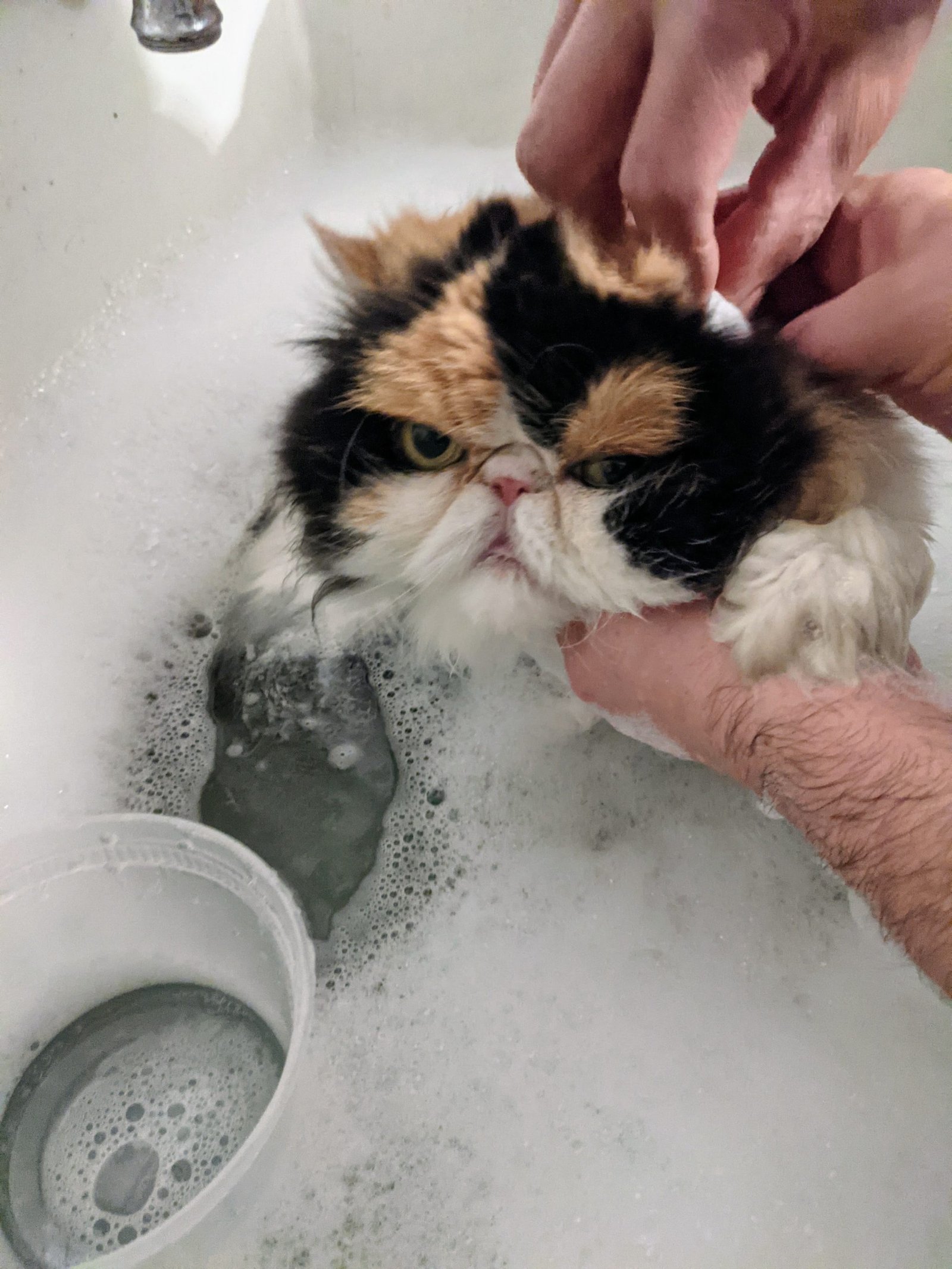Persian cats, with their grandiose appearance and luxurious coat, are undeniably captivating creatures. But amidst their regal allure, a question arises: do these majestic felines require regular baths? Well, contrary to popular belief, Persian cats do not necessarily need to be bathed frequently. Due to their long, thick fur, these fluffy wonders are naturally self-groomers who often manage to keep themselves clean. However, occasional baths can prove beneficial in ensuring their coat remains healthy and untangled, as well as addressing any hygiene concerns. So, let’s explore the factors that influence the bathing needs of these beautiful furry companions.
Introduction
Importance of regular baths for Persian cats
Persian cats are known for their luxurious and long coats, which require regular grooming to maintain their health and appearance. While many cat breeds are able to keep themselves clean through self-grooming, Persian cats often need assistance in maintaining their hygiene due to the nature of their coat. Regular baths play a crucial role in ensuring the well-being of Persian cats by preventing matting, removing dirt and allergens, and promoting a healthy skin and coat. In this article, we will explore the significance of regular baths for Persian cats and provide you with valuable information on how to properly bathe your feline friend.
Understanding Persian Cats
Physical characteristics
Persian cats are a breed known for their distinctive physical characteristics. They have a round face with a short nose, big round eyes, and a compact and muscular body. Persian cats also possess a long and flowing double coat, consisting of a dense undercoat and a longer, silky topcoat. Their coat, which comes in various colors and patterns, is one of their most defining features.
Coat type and grooming requirements
Due to their long and dense coat, Persian cats require regular grooming to prevent matting and keep their fur in top condition. Their coat is prone to tangling and accumulating debris, so grooming sessions must be a consistent part of their routine. It’s essential to brush their coat daily, paying special attention to areas prone to matting, such as the underarms and behind the ears. Regular grooming helps maintain the natural oils of their skin and prevents their coat from becoming dull or tangled.
Unique needs of Persian cats
In addition to their grooming requirements, Persian cats have unique needs that make regular baths necessary. The structure of their face and nose can cause tear stains, which require gentle cleaning. Their long fur around the facial area can also trap food particles or become soiled, leading to hygiene issues. Regular baths help keep their face clean, reducing the risk of skin infections and discomfort. Understanding these specific needs of Persian cats is crucial for providing them with the proper care they require.
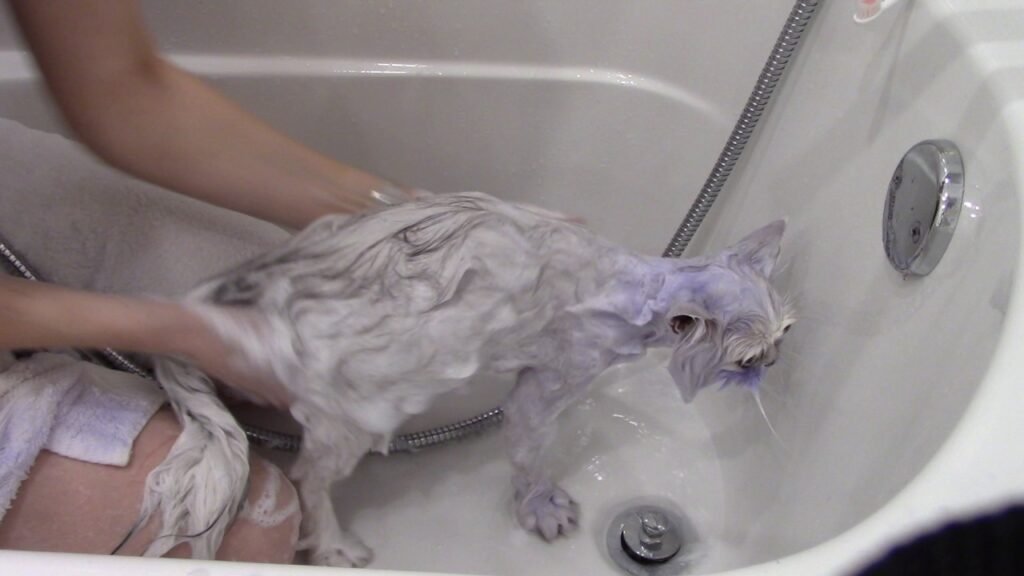
This image is property of i.ytimg.com.
Persian Cat Hygiene
Self-cleaning abilities
While most cats are adept at self-grooming, Persian cats have limited self-cleaning abilities. Their long coats can make it difficult for them to groom themselves effectively, resulting in a higher chance of matting and hygiene-related issues. It’s important to support their self-cleaning efforts by providing regular baths to ensure their coat remains clean and healthy.
Potential hygiene issues
Without regular baths, Persian cats may experience several hygiene-related issues. Their long fur can become matted, leading to discomfort and even skin infections. Dirt, debris, and allergens can also build up in their coat, causing skin irritation. Additionally, the facial area of Persian cats is prone to stains and can collect food particles, which may attract bacteria if not cleaned properly. By addressing these potential hygiene issues through regular baths, you can help your Persian cat stay clean and comfortable.
Maintenance of eye and facial areas
One of the specific hygiene needs of Persian cats is the maintenance of their eye and facial areas. Tear stains, which are common in this breed, can occur due to the shape of their face and nose. These stains can be unsightly and may contribute to skin irritation if not addressed. Regular baths can help keep the face clean, minimizing the appearance of tear stains and preventing skin issues. Gently cleaning the eye area and using cat-safe products designed for tear stain removal is crucial for maintaining your Persian cat’s hygiene.
Bathing Persian Cats
Frequency of bathing
Determining the frequency of baths for your Persian cat depends on several factors, including their individual needs, lifestyle, and coat condition. Generally, it is recommended to bathe Persian cats every 4-6 weeks to prevent matting, maintain cleanliness, and promote a healthy coat. However, some cats may require more frequent baths if they have specific hygiene issues or if their coat becomes excessively dirty.
Choosing the right cat shampoo
When bathing your Persian cat, it is essential to choose a cat shampoo specifically formulated for feline use. Human shampoos or products intended for other animals can be harmful to cats due to their different pH levels and potential toxic ingredients. Look for cat shampoos that are mild, hypoallergenic, and free from harsh chemicals or fragrances. Your veterinarian or a trusted pet supply store can recommend suitable shampoos for Persian cats.
Preparing for the bath
Before giving your Persian cat a bath, it is crucial to prepare the necessary supplies and create a safe and comfortable environment. Gather all the items you will need, such as cat shampoo, towels, a non-slip mat for the bathtub, and a brush or comb. Place a few inches of warm water in the bathtub or sink, ensuring it is not too hot or cold for your cat’s comfort. Clear the bathing area of any potential hazards or objects that could cause stress or injury to your cat.
Bathing techniques for Persian cats
When bathing your Persian cat, it is important to approach the process with patience and gentleness. Begin by wetting their coat thoroughly, taking care to avoid getting water into their ears or eyes. Apply a small amount of cat shampoo, lather it gently into their fur, and carefully work it through their coat, paying attention to areas prone to matting or soiling. Rinse the shampoo out thoroughly, ensuring that no residue remains. Towel-dry your cat, and if they tolerate it well, you can use a blow dryer on a low setting to further dry their coat. However, be cautious not to use excessive heat or position the dryer too close to your cat’s sensitive skin.
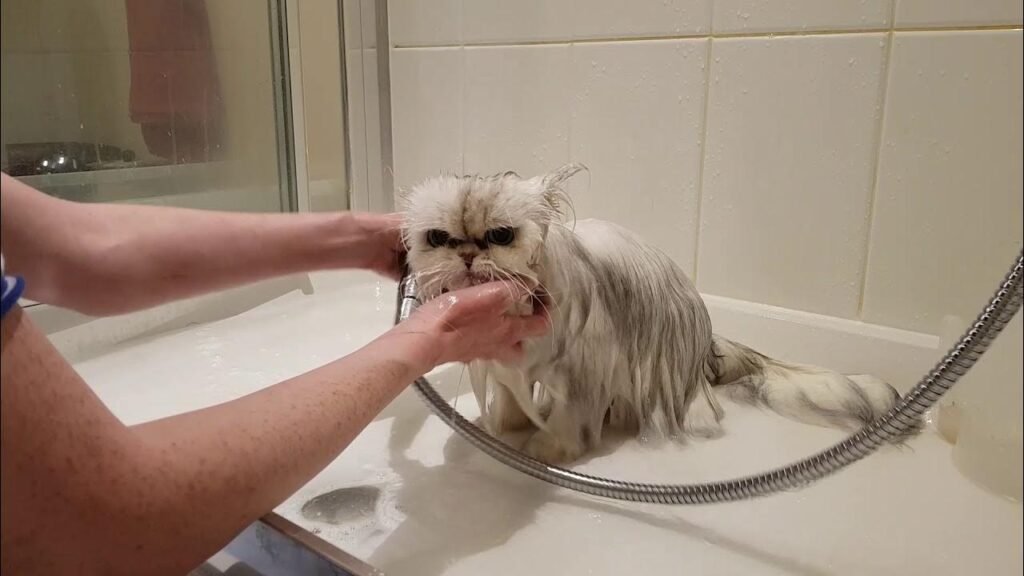
This image is property of i.ytimg.com.
Benefits of Regular Baths
Improving coat quality and appearance
Regular baths for Persian cats contribute to the overall improvement of their coat quality and appearance. The removal of dirt, debris, and excess oils through bathing helps keep their coat clean, fresh, and free from odors. A clean coat also enhances the natural shine and beauty of their fur, making your Persian cat even more stunning.
Preventing matting and tangling
One of the significant benefits of regular baths is the prevention of matting and tangling in a Persian cat’s coat. Regular brushing alone may not be sufficient to prevent mats from forming, as tangles can be challenging to remove once they’ve become severe. Bathing helps loosen any potential tangles and provides an opportunity to detangle the coat while it is wet. By incorporating regular baths into your grooming routine, you can take proactive steps to prevent matting and keep your Persian cat’s coat silky and manageable.
Removing dirt, debris, and allergens
Persian cats, with their long and luscious coats, are more likely to accumulate dirt, debris, and allergens compared to short-haired breeds. Regular baths help remove these particles from their coat, ensuring a cleaner living environment for both your cat and your family. By eliminating allergens through bathing, you can potentially reduce your own allergy symptoms or those of family members who are sensitive to cat dander.
Maintaining a healthy skin and coat
Regular baths contribute to the maintenance of a healthy skin and coat for Persian cats. By removing dirt, excess oils, and potential irritants, you can help prevent skin issues such as dryness, itchiness, or flakiness. Bathing also stimulates blood circulation in the skin, promoting a healthier coat growth and reducing the risk of skin infections. When combined with a proper grooming routine, regular baths can significantly contribute to the overall well-being of your Persian cat.
Preventing skin infections
Skin infections are a concern for many pet owners, and Persian cats are no exception. Their long and dense coats can create an environment ideal for bacteria and fungi to flourish if proper care is not taken. Regular baths help cleanse the skin, minimizing the risk of skin infections, hot spots, or dermatitis. By incorporating regular baths into your Persian cat’s grooming regimen, you are taking essential steps to protect their skin health and overall comfort.
Considerations for Bathing
Understanding your cat’s preferences
While regular baths are beneficial for Persian cats, it’s important to respect your feline friend’s preferences and comfort levels. Some cats may inherently dislike water or find the bathing process stressful. Observing and understanding your cat’s behavior and reactions during bath times can help you gauge their comfort and adjust your approach accordingly. If your cat shows signs of extreme stress or aversion to water, it may be necessary to explore alternative cleaning methods or consult a professional groomer.
Grooming challenges for Persian cats
Grooming Persian cats, including bathing, can present certain challenges due to their unique coat and temperament. Their long and dense fur requires extra care and time during grooming sessions. Some Persian cats may require regular trimming or specialized grooming techniques to maintain their coat’s quality. Additionally, their calm and gentle nature should be considered during the bathing process, as a stressed or frightened cat may become difficult to handle. Patience, consistency, and a gentle touch are key when grooming and bathing Persian cats.
Avoiding excessive bathing
While regular baths are important for Persian cats, it’s crucial to strike a balance and avoid excessive bathing. Over-bathing can strip the natural oils from your cat’s skin and coat, leading to dryness, irritation, and potentially causing more harm than good. It’s advisable to consult with your veterinarian or a professional groomer to determine the appropriate bathing frequency for your Persian cat, taking into account their individual needs and the condition of their coat.
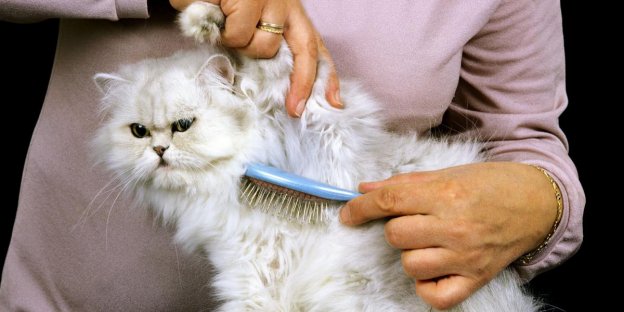
This image is property of cats.com.
Step-by-Step Guide to Bathing
Creating a calm and safe environment
Before beginning the bathing process, ensure that you create a calm and safe environment for your Persian cat. Choose a quiet room with minimal distractions where your cat can feel comfortable. Close any doors or windows to prevent their escape and use a non-slip mat in the bathing area to provide stability and prevent accidents. Maintaining a calm environment helps reduce stress and anxiety for both you and your cat during the bathing process.
Preparing necessary supplies
Gather all the necessary supplies you will need for bathing your Persian cat. These typically include cat shampoo, towels, a non-slip mat for the bathing area, a brush or comb, and potentially a blow dryer. Having everything prepared beforehand ensures a smoother and more efficient bathing experience for both you and your cat. Additionally, keep treats or rewards nearby to offer positive reinforcement throughout the process.
Brushing and detangling before the bath
Before wetting your cat, take some time to brush their coat thoroughly, paying extra attention to any mats or tangles. Brushing helps loosen any knots and removes loose hairs, making the bathing and drying process easier. Gently comb through the fur, ensuring there are no snags or tangles that may become more difficult to address once wet. By detangling the coat before the bath, you can prevent further matting and make the bathing experience more comfortable for your Persian cat.
Wetting and shampooing the cat
Once your cat is prepared, wet their coat thoroughly with warm water, making sure to avoid getting water into their ears or eyes. Use a cat-specific shampoo, applying a small amount and gently lathering it into the fur, starting from the neck and working your way down the back and sides. Take care not to apply excessive pressure or harsh movements that may cause discomfort or irritate your cat’s skin. Focus on areas prone to matting or soiling, ensuring that the shampoo reaches the skin and thoroughly cleanses the coat.
Rinsing and drying techniques
After shampooing, rinse your Persian cat’s coat thoroughly, ensuring that no residue remains. Residual shampoo can cause skin irritation or leave the coat looking dull. Use lukewarm water and gently squeeze out any excess water from the fur. Towel-dry your cat by carefully patting their coat to remove moisture. If your cat tolerates it well, you can use a blow dryer on a low setting to further dry their coat. However, be cautious not to use excessive heat or hold the dryer too close to your cat’s sensitive skin. Ensure your cat is completely dry before allowing them access to cool or drafty areas to prevent chills.
Post-bath care and rewards
Once your Persian cat is dry, take a moment to provide post-bath care and rewards. Brush their coat gently to ensure there are no remaining tangles or knots. Reward your cat with treats, praise, or playtime to reinforce positive behavior and create a pleasant association with bathing. Offering this positive reinforcement after each bath encourages your Persian cat to view the experience as a rewarding and enjoyable part of their routine.
Alternate Cleaning Methods
Using dry shampoo or wipes
In some instances, bathing may not be feasible or suitable for your Persian cat. It could be due to their aversion to water, health conditions, or other factors that make traditional baths challenging. In such cases, alternative cleaning methods like dry shampoo or cat wipes can be used to keep your cat clean between baths. Dry shampoo is designed to be applied directly to the fur and then brushed out, removing dirt and oils. Cat wipes are pre-moistened cloths that can be used to wipe down your cat’s coat, face, or paws, providing a quick and convenient cleaning solution.
Professional grooming services
If you find grooming or bathing your Persian cat challenging, or if you simply prefer professional assistance, consider utilizing the services of a professional groomer. Professional groomers have experience working with various cat breeds, including Persians, and can provide expert care and handling during the bathing process. They have the knowledge and specialized tools to ensure your cat’s coat is thoroughly cleaned and properly groomed. Professional grooming services can be especially helpful if your cat has specific hygiene needs or if you are unsure about proper bathing techniques.
Regular brushing and combing
Regular brushing and combing are essential for maintaining your Persian cat’s coat between baths. Brushing not only removes loose hairs and prevents matting but also stimulates blood circulation in the skin, promoting a healthier coat. Depending on the length and condition of your cat’s coat, brushing may be required daily or at least a few times a week. Use a brush or comb specifically designed for long-haired cats, focusing on areas prone to matting, such as behind the ears and under the arms.
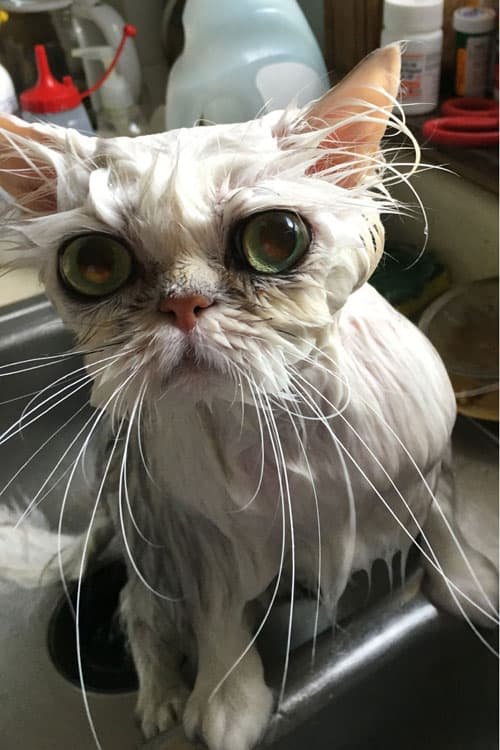
This image is property of thecatsite.com.
Common Bathing Challenges
Resistance or aversion to water
It is not uncommon for cats, including Persian cats, to exhibit resistance or aversion to water. Cats have a natural dislike for being submerged, as it can be an unfamiliar and potentially stressful experience for them. If your Persian cat shows signs of fear or resistance towards water, it’s important to approach bathing with patience and understanding. Gradually introducing your cat to water, using positive reinforcement techniques, and taking slow steps can help alleviate their aversion to water over time.
Dealing with anxiety and stress
Bathing sessions can sometimes cause anxiety and stress in Persian cats, particularly if they have had negative experiences with water in the past. To help alleviate anxiety, create a calm and quiet environment, use gentle and reassuring tones during the process, and offer treats or rewards throughout. Understand and respect your cat’s boundaries and provide breaks if needed. If your cat’s anxiety persists or becomes severe, consult with a veterinarian or animal behaviorist for additional guidance and support.
Handling sensitive areas
Persian cats have certain areas that may be more sensitive during the bathing process, such as the face, ears, and tail. It’s important to approach these areas with extra care and gentleness to prevent discomfort or injury. Take your time and use soft, slow movements when cleaning around the eyes, ears, and mouth. Avoid getting water or shampoo directly into the eyes or ears, as this can cause irritation or infections. Be patient and understanding, and always prioritize your cat’s comfort and well-being.
Conclusion
Final thoughts on bathing Persian cats
Regular baths are essential for maintaining the hygiene, health, and well-being of Persian cats. Their long and luxurious coats require extra care and attention, and bathing plays a crucial role in preventing matting, removing dirt, debris, and allergens, and maintaining a healthy skin and coat. By understanding the unique needs and characteristics of Persian cats, choosing the right grooming products, and employing proper bathing techniques, you can ensure that your feline friend enjoys the benefits of regular baths. Remember to respect your cat’s preferences, seek professional assistance when needed, and provide positive reinforcement to create a positive bathing experience for both you and your Persian cat. With proper care and attention, your Persian cat’s coat will continue to dazzle and their overall health will thrive.
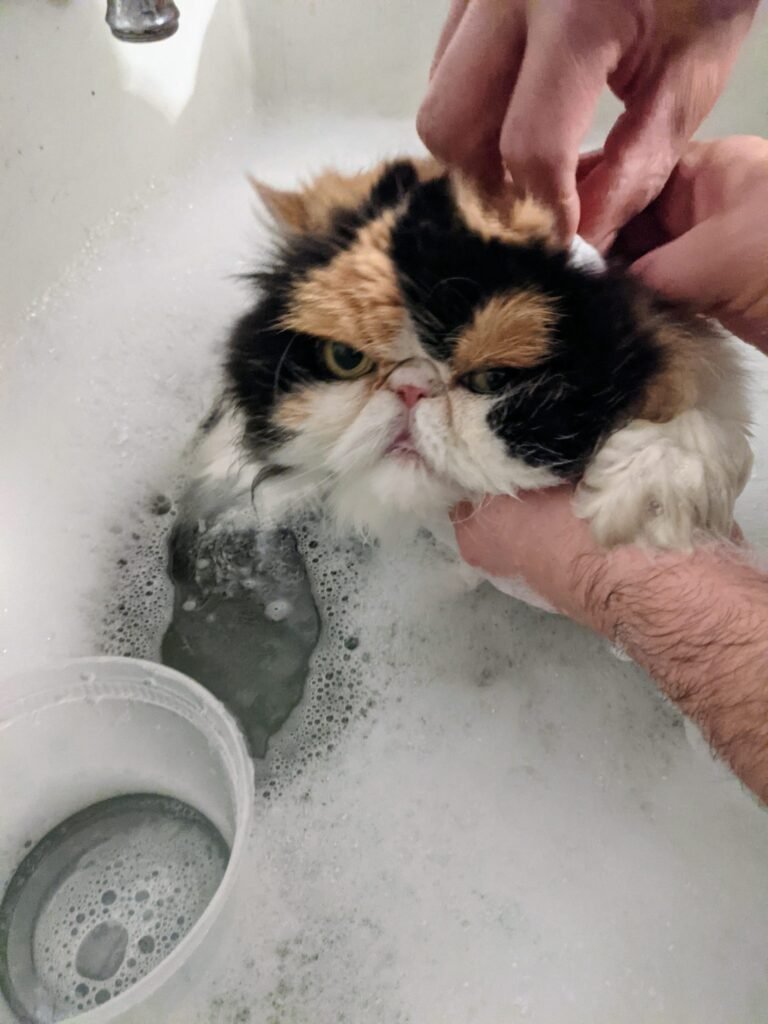
This image is property of static.themarthablog.com.

